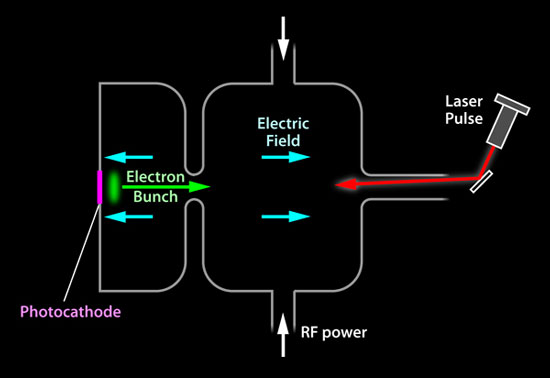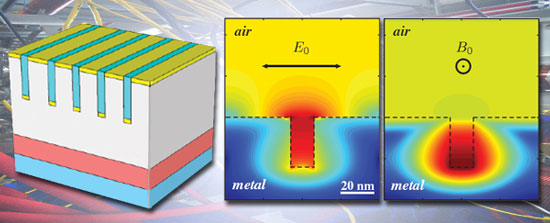| Feb 15, 2013 |
Black gold: enabling bright, high rep-rate electron beams
|
|
(Nanowerk News) Free electron lasers (FELs) have proven their worth, but next-generation light sources will have to do better than produce ultrabright x-ray pulses 100 or so times a second. What’s needed is megahertz rep rate, a million times a second. Since it’s electrons that make the x-rays, the only way to achieve that kind of performance is with an electron gun that can deliver tight electron bunches with high charge, high energy, and a very high repetition rate – sources like Berkeley Lab’s futuristic APEX, for which Howard Padmore of the Advanced Light Source (ALS) and his colleagues are designing the photocathodes.
|
|
Photocathodes produce electrons when hit by a laser beam, a process called photoemission; in accelerators the electron bunch is immediately accelerated inside a high-gradient cavity to minimize the effects of the like-charged particles blowing the bunch apart. With metal photocathodes, ultraviolet (UV) lasers are the usual choice to excite photoemission, with photon energy near the energy needed to free electrons from metals.
|
 |
| In an electron gun, the photocathode emits electrons when illuminated by a laser pulse, which is immediately accelerated by a strong electric field. The same aperture provides the exit for the electrons and the entrance for the laser light. (After Alan Stonebreaker/APS)
|
|
But surprisingly, at the necessary high laser intensities, infrared light (IR) can be more efficient than even well-matched UV pulses. The secret: multiphoton processes using IR – those in which four photons, for example, arrive virtually simultaneously and excite emission of a single electron. With high-rep-rate IR lasers, electron bunches from the photocathode retain the laser’s femtosecond (quadrillionth of a second) time structure.
A set of groove-like, gold-floored nanocavities were carved in gold-plated aluminum from a template produced by electron beam lithography. The grooves cause an order of magnitude electric field enhancement at the mouth of the nanocavity and a like enhancement of the magnetic field at its base. Laser light is normal to the surface.
|
|
A set of groove-like, gold-floored nanocavities were carved in gold-plated aluminum from a template produced by electron beam lithography. The grooves cause an order of magnitude electric field enhancement at the mouth of the nanocavity and a like enhancement of the magnetic field at its base. Incidence of laser light is normal to the surface.
|
|
Unfortunately metals reflect IR rather than absorb it, so under ordinary circumstances little of the incident light does work. To address this problem Alex Polyakov, Padmore’s former graduate student now at the Molecular Foundy, worked with Jim Schuck and Stefano Cabrini to create a photocathode light trap and electron amplifier, carving parallel grooves 15 nanometers wide, 60 nanometers deep, and just 100 nanometers apart (a nanometer is a billionth of a meter) in gold-plated aluminum – a pattern smaller than a laser’s wavelengths.
|
|
The grooves served as resonators of plasmons – quantized vibrations in the oscillation of surface electrons – interacting with the incident laser light to amplify and control the photoemission of electrons. With colleagues at the Pacific Northwest National Laboratory the team showed that the device completely absorbed the laser light, eliminated reflection, and produced a million times more electrons than an IR laser on bare gold.
|
 |
| A set of groove-like, gold-floored nanocavities were carved in gold-plated aluminum from a template produced by electron beam lithography. The grooves cause an order of magnitude electric field enhancement at the mouth of the nanocavity and a like enhancement of the magnetic field at its base. Incidence of laser light is normal to the surface.
|
|
Colleagues of Padmore’s at UCLA who had been developing IR-based photocathodes applied these plasmonic photocathode principles to the electron gun of a real accelerator. Instead of nanogrooves, graduate student Renkai Li of Pietro Musumeci’s group drilled an array of nanoholes in copper. Theirs was the first demonstration of relativistic electron beams from a nanostructured photocathode in a high-gradient accelerating structure; with it they were able to perform the first measurements of beam quality.
|
|
Plasmonic photocathodes hold the promise of manipulating light fields on the nanoscale at will, in the same way that RF fields are used today, opening many new possibilities for the creation of ultrabright electron sources.
|
|
Both reports appear in the same issue of Physical Review Letters at http://prl.aps.org/abstract/PRL/v110/i7/e076802 and http://prl.aps.org/abstract/PRL/v110/i7/e074801 respectively. A helpful Viewpoint introduces both.
|


